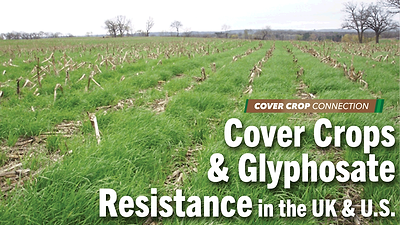Studies about cover crops from many of the semi-arid Great Plains have been cautionary or conditional, owing to potential concerns about soil moisture or nutrient use from covers seeded ahead of cash crops.
But Kansas State University researchers say they’re seeing some encouraging results with covers when the benefits are studied over multiple years.
Their ongoing study is determining how long-term effects of legume and non-legume summer and winter cover crops grown before grain sorghum impact nitrogen (N) availability and the response of sorghum yield to N fertilization.
The crop rotation they use is wheat-grain sorghum-soybean and the cover-crop treatments include four different combinations: summer legume (SL)-forage soybean; summer non-legume (SNL)-sorghum-sudangrass; winter legume (WL)-crimson clover and winter non-legume (WNL)-daikon radish.
The study also included double crop soybeans (DSB) as a cash crop alternative, and a chemical fallow (CF) check. These treatments were done following wheat harvest so grain sorghum is the crop in the rotation most likely to be affected. Nitrogen fertilizer was applied after grain sorghum planting in a subsurface band at 0, 40, 80, 120, and 160 pounds per acre.
Here’s what researchers Giovani Preza Fontes, Peter Tomlinson, Kraig Rooseboom and Dorivar Ruiz Diaz found:
- After three cycles of cover crops, grain sorghum yields with no N fertilizer applied were highest following the summer legume cover crop treatment. A minimum of about 35 pounds an acre of added N fertilizer would be required for sorghum yields to reach similar yield levels with the CF and other cover crop treatments.
- Grain sorghum planted after the summer legume and double-crop soybean cover crops produced significantly greater yields than the other treatments when no fertilizer N was added. There is potential to replace a portion of the cash crop N requirement with summer legume cover crops, researchers say.
- The summer legume cover crop contributed an average of 33 pounds per acre to grain sorghum during the growing season, and double-crop soybean contributed an average of 19 pounds.
- On the other extreme, researchers say, sorghum-sudangrass, a summer non-legume, removed an average of 47 pounds of N per acre from the plant-available soil N pool.
“Sorghum-sudangrass has a relatively high carbon-to-nitrogen (C:N) ratio which leads to immobilization (tie-up) of available soil N,” they say. “For cover crops with high C:N ratios, additional N input by the grower may be necessary to maintain sorghum or corn yields.”
They added that the agronomically optimum fertilizer rate for sorghum after an 8-year average of yield data was approximately 80 pounds an acre for all treatments except where a summer non-legume cover crop (sorghum-sudangrass) was used. With the summer non-legume cover crop, the agronomically optimum fertilizer rate was 120 pounds per acre.
Some ‘experts’ in the Great Plains frequently predict a yield hit to cash crops coming after cover crops due to a potential lack of soil moisture or other concerns.
So it’s refreshing to see a longer-term study that shows more realistic scenarios possible with long-term cover crop adoption if C:N ratios and N applications are managed properly.




